- EXCLUSIVE
INTERVIEW
JACKSON
BOSTWICK
conducted
August, 2003
I recently had the good fortune to contact Jackson
Bostwick and correspond with him about his time on the show and
the things he's done before and since. The resulting interview
is presented here.
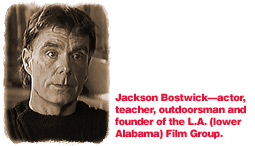
What are some of your more memorable early projects and
celebrities you worked with?
JB: "The Late Liz" was my first film. I played
the ex-husband of Anne Baxter in one scene in a hospital operating
room. She was incredible to watch work. For seven different setups
she had to have a total breakdown with tears flowing, and with
me, Jim Gregory, and Steve Forrest right in her face. What a
lesson in performing! She told me, "Jackson, never give
up! ... never!"
I did my first lead in a feature film with Cameron Mitchell
called "The Hughes Mystery". Broderick Crawford was
on board for a week, and he and I became very good friends. Every
morning he had me come over to his condo just off of Sunset Boulevard
where his lovely wife would have bagels and lox for us before
we went in his limo out to the set. He, by himself, would start
the day off with an entire magnum of champagne; then at lunch
he would have around six or seven doubles. And I want to tell
you, I could not notice any effect on him, whatsoever. His performance
on camera was machine-gun in pace and always precise. All this
with an unrepaired hernia, and being blind in one eye. One day,
during a scene in a hospital bed when things were dragging with
the crew getting set up, he started to violently cough and turned
red in the face and had the director/producer back-stepping,
and all of us wondering if he was about to drop over dead. While
everyone was flitting around like a Chinese fire drill, he whispers
to me, "are ya learning anything, kid?" He winks with
his good eye, then goes back to coughing like he was tearing
out a lung. The scene was completed in warp speed, and we wrapped
early that day. I think he outlived all his doctors!
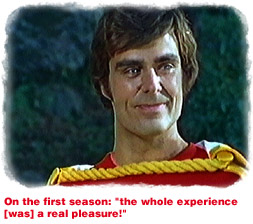
You've mentioned in the past that you greatly preferred
the first season of Shazam! to the way the second season
was working out. Perhaps you could elaborate on what made that
first year more enjoyable.
JB: The first season of Shazam! was skippered
by Bob Chenault as producer; a wonderful boss. Without a doubt
he made the show what it was, and the whole experience a real
pleasure. With his untimely exit the second season, the entire
production took an accelerated nosedive in quality, including
my abrupt firing by the executive producers (a snafu that would
have never occurred on Mr. Chenault's watch) and their sycophant
replacement of Bob, Arthur Nadel.
The head of the fish always has a stink to it, but when Mr.
Chenault was cut out of the neck the pollution crept down to
other parts of the fish, as well. Walt Disney Studios in the
'70s was a great company to work for; but there I had my casting
friend Bill Shepard. It was like a family, then, but when the
Disney family backed off from hands-on participation in the late
'70s, it all changed. It became just another hatchet studio.
I guess, as in life, it all depends on who's driving the bus,
and who's watching your back.
Do you think that Isis entering production the second
year took a hit on the production values of your show?
JB: Isis was a creation of Filmation (they didn't
own Shazam!) to ride the coattails of Shazam! and
yes, from what I understand, with Isis being owned, and
both shows being controlled by Filmation, there were definitely
a lot of production "robbing-Peter-to-pay-Paul" shenanigans
going on when the new show arrived.
Were you looking forward to doing guest spots on Isis
or had that even been discussed before you left? Any impressions
of the Isis cast?
JB: Isis would have been fun to work on. Before
my sudden release, I had even given Filmation's executive producers
some ideas on a couple of story plots for "the Big Red Cheese"
and the Egyptian fertility goddess that would have been a hoot.
The whole cast of Isis did a wonderful job of creating
a good show. Joanna Cameron and I did a public appearance together
in Dallas recently, and she is a real pleasure to do Q&A
with. Brian Cutler and I have run into each other on occasion
over the years, and we've always enjoyed a good chat. The other
cast members, I have not had contact with.
What was your working relationship with your Shazam!
co-stars, Michael Gray and Les Treymane?
JB: On the set Michael and Les were professional and
courteous ... to my face; behind my back on the set, and off
the set ... read about that in my forthcoming book, "Myth,
Magic, and a Mortal."
During production, I understand you did some public appearances
in costume. What were those like?
JB: I did very few appearances in costume. Filmation
tried to stop that, too (again, litigation straightened that
snafu all out). "If we can't send you out, then nobody can,"
was what I was told by Norm Prescott in Lou Scheimer's office,
one day (This was right before Jack Wrather tried to stop Clayton
Moore from wearing the Lone Ranger mask). These guys are real
peaches.
Anyway, I did do the Hollywood Santa Claus Lane Parade in
1974, and John Wayne (he was the Grand Marshall that year) comes
up to me in the staging area and, putting his arm around me,
drawls in that 'John Wayne drawl,' "I always wanted to be
in a picture with Captain Marvel." Somebody snapped a picture
of us, and to this day I have never seen a copy of it!
I know you did a lot of stunt work on Shazam!, some
of it probably dangerous. Any close calls or dangerous stunts
you'd like to elaborate on?
JB: I had several close calls over the course of the
show that I go into detail within the book. One, I recall, was
where I stop the hijacked motor home by grabbing onto the side
of a tunnel (in Griffith Park in Los Angeles). I had to stand
on the top of the vehicle with no safety straps, and, in order
for my cape to fly out, the speed of the vehicle had to be over
40 mph. This doesn't sound so difficult, but what made it dangerous
was the cushy ride from the motor home's springs. It was like
surfing on a bowl of Jell-O in a wind tunnel! I nearly went over
the edge twice, and that would have been "lights out,"
hitting the asphalt from 12 feet up, doing over 40 mph!
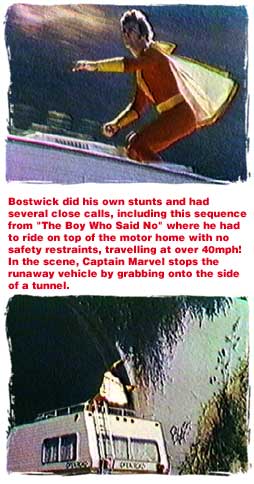
|
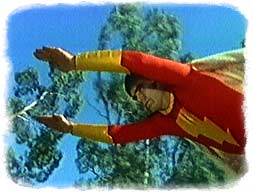
What were the flying sequences like to do? Did
any of the instances of the Captain displaying his superhuman
powers prove particularly challenging?
JB: I came up with the idea of doing a back
arch while strapped to a diving board-type apparatus projected
out over the front of a camera car; then filming from the waist
out from a low angle. Crude, but it worked. I had wanted them
to put a wire on me, attach it to a helicopter and have me walk
out into a field and just lift off. "No," they said,
"Too dangerous. You get hurt and the show shuts down!"
Tell us a little bit about your abrupt dismissal
from Shazam! during production of the second season.
JB: I go into great detail about this occurrence
in my upcoming book. Briefly, I was wrongly accused of, as Filmation
insinuated, not reporting to work one morning with the intention
of trying to hold up production because I was holding out for
more money. Baloney! I was at the doctor's office having my face
and eye examined for an injury that I incurred doing a stunt
on the previous day (during the filming of a flying takeoff sequence
where the stunt boxes hadn't been reset properly).
I couldn't have filmed that day as Captain Marvel,
anyway - I had this huge "mouse" under my right eye.
The Screen Actors Guild arbitrated, Filmation lost, and had to
pay me for all of the shows they had me set to do, plus residuals
(Bostwick, incidentally, had 8mm home movie footage of the accident
which made for very compelling evidence in the arbitration hearing),
but the capper ... John Davey was, willy nilly, thrown into the
part! The whole thing was sad and stupid.
[When I was fired, their attitude] was, "Fire
him! The kids'll never know the difference..." And they
did [fire me]... but they (the kids) did [knew the difference].
Did you have any contact with people working
at Filmation (cast, crew or otherwise) after you left the show?
Apart from your dismissal, how did you feel about working at
Filmation?
I went deer hunting with my safety man "Big
John" Carroll on the southern boundary of Yosemite Park.
I, also, became very good friends with Bob Chenault, and we use
to sail in his 60 foot sailboat over to Catalina almost every
weekend for several years afterwards. I'd dive up some abalone
and we'd cook them on a hibachi on the rear deck.
I can't say working for Filmation was bad. Bob
Chenault was who I worked for, and he made it great. Almost everyone
on the crew was great.
Until fairly recently, playing a super-hero
often carried a certain stigma. Are you comfortable with mainly
being known as Captain Marvel?
JB: As comfortable as I am with Sean Connery
mainly being known as James Bond.
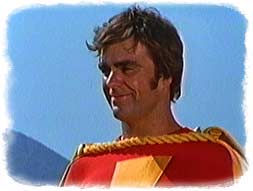
Were you particularly aware of the large following
Shazam! has had in recent years? Did you happen to catch
any of the TV Land reruns and did the fact they ran a few of
them in the past couple of years leave any impression on you?
JB: I've gotten very positive feedback from
young people who never saw the show in the '70s. Their parents
who did watch the show then are happy to let their kids see the
show, for it's good family entertainment. The only complaints
I've heard are the disappointments in the fact that TV Land has,
for some reason, cut out the message at the end of the show where
Captain Marvel flies back and talks to the kids. This, they said,
was their favorite part of the series, and wish it would be shown
in it's entirety; not just ending with the two TV Land hosts
jawboning among themselves. I have yet to catch an episode on
this outlet. With the new "Shazam!" movie in the works
with New Line Cinema, however, I guess things are going to start
up all over again.
You seem to be busy on the convention circuit.
Do you find it enjoyable?
JB: Always. Meeting different people who
tell you they grew up glued to the TV set watching the show lets
you know it wasn't all for naught.
What sort of off-screen things did you do after
Shazam?
JB: With an MFA (from USC) and being a professional,
I can teach academically, and have taught at college level (Auburn
University at Montgomery). I have also taught professional acting
workshops outside of the area of academia on different occasions,
and will be doing so when my family and I move to Nashville to
restart my film company, L.A. (lower Alabama) Film Group.
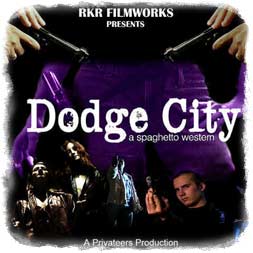
Could you tell us a little about your new project,
"Dodge City?"
JB: It's a "spaghetto" western
shot in Nashville. A group of us good guys and hired guns go
into a 'hood and clean house, ala "The Magnificent Seven."
On the Where Are They Now? segment, it
was mentioned you are an outdoorsman and have a cabin. Tell us
a little bit about your interest in the outdoors and any hobbies
you might have.
JB: I enjoy most all outdoor sports such
as water skiing, snow skiing, scuba diving and snorkeling, hunting,
all shooting sports, archery, golf, flying (I have a commercial
pilot's license), etc. I'm looking out my window right now watching
eight wild turkeys (two with over 8" beards) feeding on
some seed at my bird feeder. I love it!
Who were some of your heroes growing
up?
JB: My heroes in fiction were: Clayton Moore
as the Lone Ranger, Johnny Weissmuller and Lex Barker as Tarzan,
Sergeant Preston of the Yukon, Sean Connery as James Bond; Tom
Tyler in the original 1941 serial "The Adventures of Captain
Marvel" and, of course, C.C. Beck's Golden Age comic rendition
of the original Captain Marvel from Fawcett Publications.
My hero in real life: my dad.
Thanks, Jackson!
No part of this interview may be reproduced
in any form without written consent from the webmaster.
|
